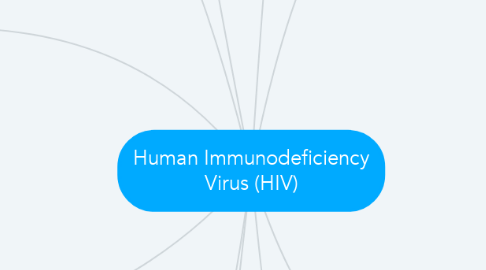
1. Mechanism
1.1. 1) HIV will attach to the host's receptor and penetrate their target's cell
1.2. 2) HIV will release RNA into the cell and it must be replicated into DNA
1.3. 3) DNA is being formed with the help of and enzyme that is called reverse transcriptase
1.4. 4) Viral DNA enters the cell's nucleus
1.5. 5) Viral DNA is being integrated to the host's DNA by integrase
1.6. 6) DNA of the infected cell will produce viral RNA as well as proteins that are needed to assemble new HIV
1.7. 7) A new virus is assembled into RNA and some short proteins
1.8. 8) The virus buds through the cell's membrane and wraps itself in a fragment of the cell's membrane which pinches off from the cell's membrane
1.9. 9) The budded virus must be mature to be able to infect other cell so the HIV's protease will cut the structural proteins of the virus which causes them to rearrange and become mature
2. Manipulation Vaccine Development
2.1. HIV vaccine is not yet developed because
2.1.1. Lack of natural immunity to HIV
2.1.2. Variability of HIV types
2.1.3. Lack of correlates of protective immunity
2.1.4. Lack of animal model that reliably predicts vaccines efficacy in humans
3. Epidemiology Cases in Malaysia
3.1. Most common illnesses involved
3.1.1. Pneumocystis carinii pneumonia (PCP)
3.1.2. Esophageal candidiasis
3.2. 70% of new HIV infection in 2013 were Malay.
3.3. Everyday almost 10 Malaysian are diagnosed HIV positive.
3.4. 31% of newly reported cases in Malaysia are in their twenties.
3.5. In 2013 Malaysia marked more than 100000 people diagnosed with HIV since the first case in 1986.
3.6. AIDS has caused the deaths of more than 13000 Malaysians.
3.7. Quite heterogenous in its dynamic and shape
3.8. Women and girls are the fastest growing populations that are being infected
4. Molecular Method for Detection
4.1. Serological Assay
4.2. Western blotting
4.3. Virological testing
4.3.1. Detect viral nucleic acid
4.4. Dried blood spot (DBS)
5. Immune Response Involved
5.1. HIV virus attack CD4 cell,
5.2. If the number of CD4 cells (the CD4 count) is reduced, the immune system has fewer cells to help it defend the body from other organisms. The greater risk of getting ill
5.3. CD4 and CCR5 membrane proteins are targets for HIV infection
6. Treatments
6.1. Antoretroviral therapy (ART)
6.1.1. A combination of HIV medicines (HIV regimens)
6.1.2. Cannot cure HIV, but reduce transmission
6.2. The cure are not yet to be found, but treatment keeps the virus under control
6.3. Daily exercise
6.4. Well-balanced and nutritious diet
6.5. Risk taking HIV medicines
6.5.1. Side effects
6.5.2. Drugs interactions
6.5.3. Drug resistance
7. Transmission
7.1. Having sex with someone who has HIV without any protection
7.2. Sharing needles or syringe with people who has HIV
7.3. From mother to child during pregnancy or breastfeeding
7.4. Stuck with HIV-contaminated needle
7.5. Blood transfusion or organ transplant
7.6. Bitten by a person with HIV
7.7. Contact between broken skin, wounds or mucuous membrane
8. Ways of The Pathogens Evade The Host
8.1. HIV-1 enters primarily through the mucosal surfacea of genital during transmission.
8.2. HIV has enveloped spikes (trimers) to bind and infect cells.
8.2.1. It support three gp120 molecules, which HIV uses to grip and to gain entry into the cells it infects.
8.3. After gp120 bind to CD4 on the T-cell, nucleocapsids containing viral genome and enzymes enters the target cell.
9. Symptoms
9.1. Common
9.1.1. Fever
9.1.2. Sore throat
9.1.3. Body rashes
9.1.4. Severe headaches
9.1.5. Rapid weight loss
9.1.6. Memory loss, depression or other neurological disorders
9.1.7. Pneumonia
9.2. Less Common
9.2.1. Fatigue
9.2.2. Swollen lymph nodes
9.2.3. Ulcers in the mouth or genitals
9.2.4. Muscle aches
9.2.5. Joint pain
9.2.6. Nausea and vomiting
9.2.7. Night sweats
10. Characteristics
10.1. Intracellular parasite
10.1.1. requires a host cell to survive and reproduce
10.1.2. Known as CD4 T-helper cells which is crucial for the host's immune response.
10.1.3. It targets immune cells

